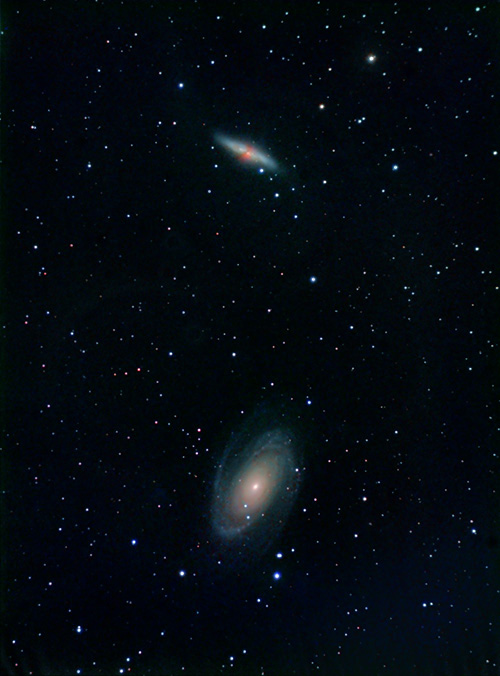|
04/13/2010: Messier 81 and 82 are a couple of showpieces in the high northern sky. They deserve better than being treated as "something to do" while waiting for M106 to clear Bird Feeder Tree so I can add color data to my previous efforts, but that is mostly how I am abusing them. To make the most of a few hours with these two, I got on the pair early and took luminance data for an hour, Moon be damned. I used short, 300-second subs to control sky glow. Then I took half an hour each in R, G, and B, also in 5 minute snippets. Here's the luminance data:
M81 & M82 Added 6 x 300s RGB to previous image
Earlier today, I registered Russell Croman's Gradient XTerminator and sent a donation to Craig Stark's Stark Labs in honor of PHD Guide. The former is shareware and does what it does very well: it's easily worth the price consdiering how much it improves images in which so much time must be invested. PHD Guide is freeware (with a donation button) and it has made all the difference in my astrophotography experience. Tonight, for example, I am using a Meade DSI Pro behind an Orion ST80 for guiding. PHD Guide is holding onto a 9.3 star nice and firmly; had it been necessary, it could as easily have guided on any of several field stars down to around 12th magnitude:
Screen capture: remote operation of Nebulosity (in background) and
Different tonight: I am using a Baader "fringe-killer" filter to cut IR and deep blue. Let's see if it helps tighten up my L and B stars and see the extent to which it frigs the color balance in the Baader LRGB filter set. When combining color with this filter, an RGB balance of 1:1:1.5 or 1.3 is not far off the mark, but there is something just a little sickly about the blues. Work on that.
M106, revisitted. Half an hour of RGB followed by another 43, 300-second L frames added to the previous clear night's result produced this:
M106 and neighbors All in all, this is not an improvement (or not very much of an improvement) on my earlier, "thinner" attempt. I'm just not happy with the sharpness within the galaxy, the tone of its inner sprial arms, and the size of the brightish stars at lower right. The stars in this web-sized version are hard-edged and "brittle" which is not so much the case in the larger versions, but they're still not right. Some of those faults are caused by shooting through haze and moonlight; part of the trouble is almost certainly due to imperfect focus. I'm having to work like crazy to control gradients and mottled "shadows" both of which are due in part to moonlit clouds. Also, I am probably pushing sparse data too hard, and I bet my flats (dawn flats made using 3 layers of stretched white t-shirt material) are not entirely flat. A clearer, darker night of RGB and nothing else would help. Nobody said it would be easy, right? I wonder if my habitual guiding with 2-4 second exposures results in chasing seeing. If so, it would be worth trying longer guide exposures and maybe setting a minimum guide correction. And hey, while you're thinking up solutions, how about a neat unattended way to shut everything down in the morning? That would be very welcome, as would a way to avoid climbing out of bed just to hang underwear over the telescope in twilight. What a hobby.
|
:: top ::
© 2011, David Cortner



